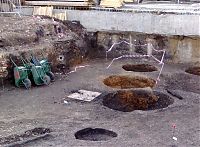More pits
- By: Gary Webster |
- Apr 01, 2008
- Share
- del.icio.us

Ahh Well….
It seems that the chance of my large brick-lined pit being a soakaway disappeared along with the horizon, as it continued to sink deeper and deeper. It’s almost certain now that it is a well. It has still not been successfully bottomed, although it will be when the machine has had the chance to take out some of the top layers, which have already been recorded. Just before I began to take out the top layers of bricks, to use the well as a window into the surrounding stratigraphy, I noticed that the bricks were not stacked on top of one another in regular courses, but instead had been built in a spiral. The same was later confirmed with Fergal’s soakaway, built in the same manner. There was a lot more back-fill in between the bricks and the construction cut than I had previously thought, with quite a few broken bricks and clay deposits being used to ‘pad out’ the sides. Once the bricks had been removed I was able to identify a number of pits which had been truncated, or cut into by, the well I had been working on. This means that these pits would be earlier than the well, although it is yet unknown if they are medieval or even Roman.
I had the chance to work in the horn-core pit recently, which was a nice change from dealing with bricks, and further away from the unholy stench that lingered around Fergal’s pit, caused by some decaying organic matter I’m told, and not the man himself. We started to take the horn-cores out carefully, as they have to be sampled. It could be frustrating work though, carefully digging around a horn-core then lifting it out slowly, only to find that the base or the tip were missing, making them less useful for sampling methods, which prefers them to be whole. The removal of these horn-cores once again gave us the opportunity to see the local stratigraphy, which contained many pits.
